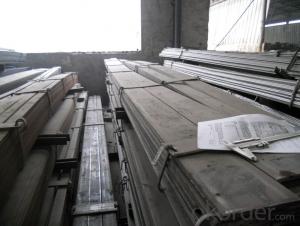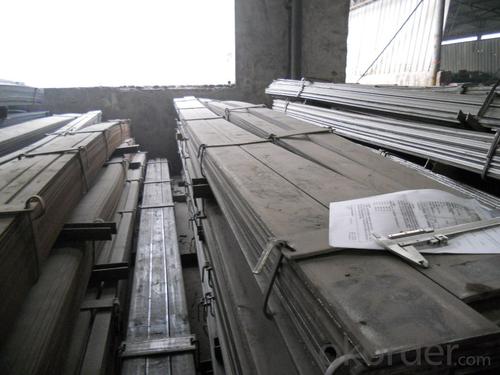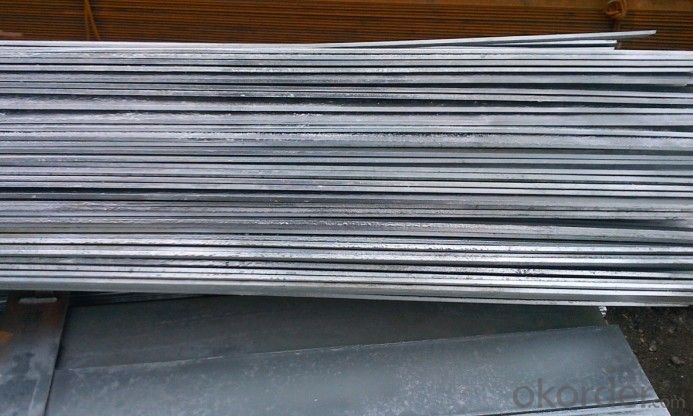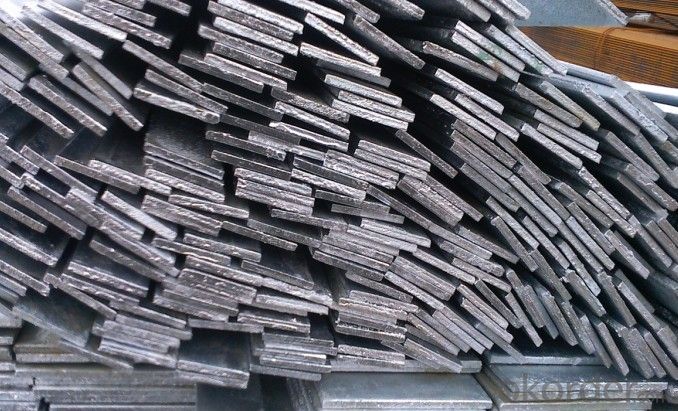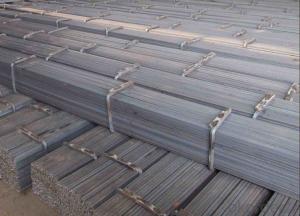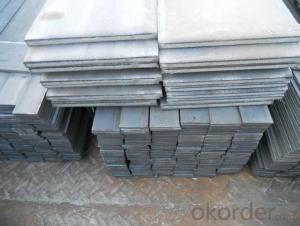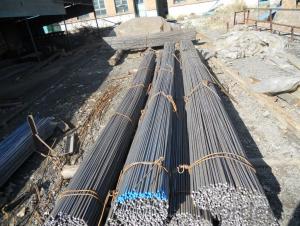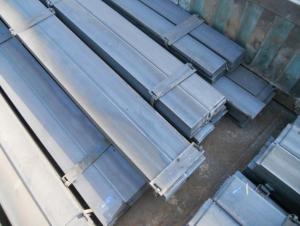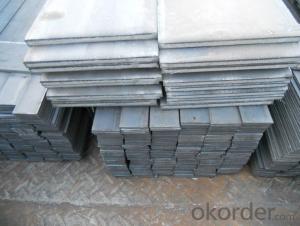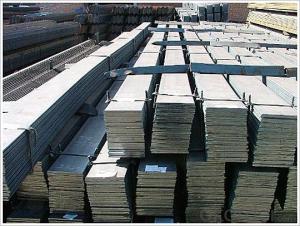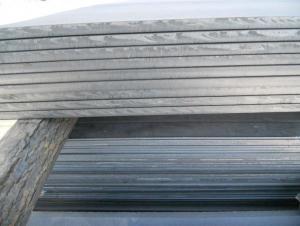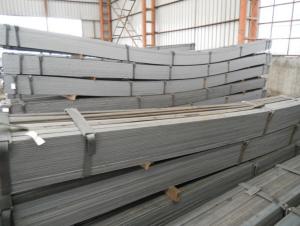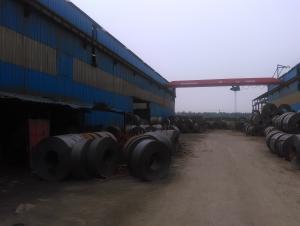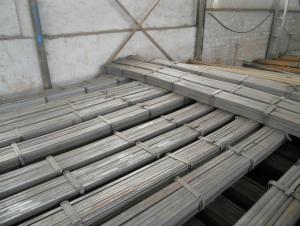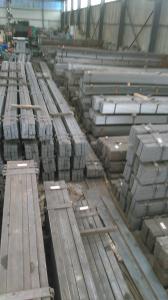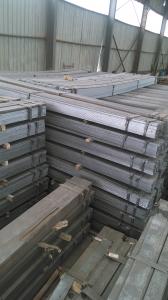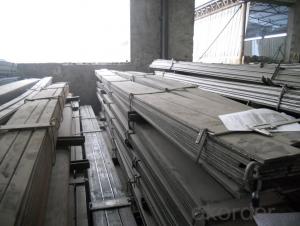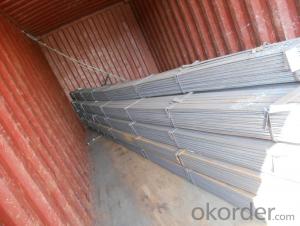high quality low carbon JIS steel flat bar
- Loading Port:
- Tianjin
- Payment Terms:
- TT OR LC
- Min Order Qty:
- 5 m.t.
- Supply Capability:
- 1000 m.t./month
OKorder Service Pledge
OKorder Financial Service
You Might Also Like
Product Description:
Specification of Mild Steel Flat Bar
Commodity: Mild Steel Flat Bar
Standard: GB;JIS
Material: Q195-235;SS400
Brand name: FLATSPACE
Origin place: China
Thickness: 3mm-30mm
Width:20mm-200mm
Length: Max 12m
Certification: SGS/BV
Chemical composition of Q235
Alloy No | Grade | Element(%) | ||||
C
| Mn
| S
| P
| Si
| ||
Q235
|
B
|
0.12—0.20 |
0.3—0.7 |
≤0.045 |
≤0.045
|
≤0.3
|
Physical properties of Q235
Alloy No | Grade | Yielding strength point(Mpa) | Tensile strength (Mpa) | Elongation after fracture(%) | ||||||
Thickness (mm) | Thickness (mm) | |||||||||
≤16 | >16--40 | >40--60 | >60--100 | ≤16 | >16--40 | >40--60 | >60--100 | |||
≥ | ≥ | |||||||||
Q235 |
B |
235 |
225 |
215 |
205 |
375--500 |
26 |
25 |
24 |
23 |
Usage/Applications of Mild Steel Flat Bar
Widely used for construction, Machinery manufacturing, Iron tower steel structure, Shipbuilding; Steel grating, Staircase, Bridge, Viaduct, Railway spare parts, Boilers making etc.
Packaging & Delivery of Mild Steel Flat Bar
Packaging Details: The Mild Steel Flat Bars are packed in bundles and loaded in 20 feet/40 feet container, or shipped by bulk cargo ,also we can do as customer's requirements.
Delivery Details:30~45 days upon the receipt of buyer payment by T.T. or L/C.
Production Flow of Mild Steel Flat Bar
The Mild steel flat bar is made through three processes:
1.Feeding the material: Feeding the row material (the steel plate) to Slitting Line.
2.Slitting:The steel plate would be slitted into expected width by lengthways cutter.
3. Leveled and cutting: The plat bar would be ground into level by the grinder and then cut into required length
- Q: What are the different cleaning and maintenance methods for steel flat bars?
- There are several cleaning and maintenance methods for steel flat bars that can help keep them looking and performing their best. Some of the most common methods include: 1. Regular Cleaning: The first step in maintaining steel flat bars is regular cleaning. This can be done using a mild detergent or soap and water solution. Simply apply the solution to the surface of the flat bar and use a soft cloth or sponge to gently scrub away any dirt or grime. Rinse the bar thoroughly with clean water and dry it using a soft, lint-free cloth. 2. Polishing: Polishing the steel flat bars can help restore their shine and remove any surface scratches or marks. There are various metal polishes available in the market specifically designed for stainless steel surfaces. Apply a small amount of polish to a microfiber cloth and rub it onto the surface of the flat bar in circular motions. Continue polishing until the desired shine is achieved. 3. Stainless Steel Cleaner: For tougher stains or marks that regular cleaning cannot remove, a stainless steel cleaner can be used. These cleaners are designed to break down and remove stubborn stains, grease, and grime from stainless steel surfaces. Follow the instructions on the cleaner's packaging for best results. 4. Rust Prevention: Steel flat bars are susceptible to rust, especially in humid or corrosive environments. To prevent rust, it is important to keep the flat bars dry and avoid prolonged exposure to moisture. If any rust spots do appear, they should be promptly removed using a rust remover or a mixture of vinegar and baking soda. After removing the rust, clean and dry the flat bar thoroughly to prevent further rusting. 5. Protective Coatings: Applying a protective coating or sealant to steel flat bars can help enhance their resistance to staining, corrosion, and scratches. There are various products available such as clear lacquers, paints, or specialized coatings specifically designed for stainless steel surfaces. Follow the manufacturer's instructions for proper application and maintenance of the protective coating. By following these cleaning and maintenance methods, steel flat bars can maintain their appearance and durability for a longer period of time, ensuring optimal performance in various applications.
- Q: What is the typical width tolerance for steel flat bars?
- The typical width tolerance for steel flat bars can vary depending on the specific grade and manufacturing process, but it is generally within a range of +/- 0.005 to 0.03 inches.
- Q: Can steel flat bars be used as reinforcement in concrete?
- Steel flat bars can indeed serve as reinforcement in concrete. They are widely recognized as either flat bars or flat steel bars. Concrete structures frequently incorporate these bars to bolster their strength, longevity, and overall stability. By integrating the steel bars into the concrete matrix, they confer tensile strength and safeguard against cracking or failure when subjected to a load. Utilizing flat bars as reinforcement in concrete yields numerous benefits, including heightened resistance to bending, augmented load-bearing capacity, and enhanced structural integrity.
- Q: Are steel flat bars suitable for making brackets or supports for fire protection systems?
- Yes, steel flat bars are suitable for making brackets or supports for fire protection systems. Steel is a strong and durable material that can withstand high temperatures, making it an ideal choice for fire protection applications. The flat shape of the bars also provides stability and ease of installation, making them well-suited for creating brackets or supports for fire protection systems.
- Q: Are steel flat bars commonly used in the furniture industry?
- Yes, steel flat bars are commonly used in the furniture industry. They are often used as a structural component in various types of furniture such as tables, chairs, and shelving units. Steel flat bars provide strength and stability to furniture pieces, making them a popular choice in the industry.
- Q: Are steel flat bars resistant to impact or shock?
- Yes, steel flat bars are generally resistant to impact or shock due to their high tensile strength and durability. They are commonly used in applications where resistance to impact or shock is required, such as construction, manufacturing, and structural projects.
- Q: Can steel flat bars be an alternative to wood in construction?
- Yes, steel flat bars can be a viable alternative to wood in construction. Steel flat bars offer several advantages over wood, making them a popular choice for various applications in the construction industry. Firstly, steel flat bars are extremely strong and durable, providing a higher level of structural integrity compared to wood. They can withstand heavy loads and resist bending or warping, making them ideal for supporting large structures or carrying heavy loads. This strength also translates to increased safety and longevity, as steel is less prone to damage from weather, pests, or decay. Additionally, steel flat bars are highly versatile and can be easily customized to suit specific construction requirements. They can be cut, welded, and bent into various shapes or sizes, allowing for greater design flexibility. This versatility makes steel flat bars suitable for a wide range of structural applications, such as beams, columns, braces, or even as reinforcements in concrete structures. Furthermore, steel is a sustainable and environmentally friendly material. It can be recycled indefinitely without losing its properties, reducing the need for new raw materials and minimizing waste. In contrast, wood is a limited resource that requires deforestation and can contribute to environmental degradation if not sustainably sourced. Lastly, steel is fire-resistant, providing enhanced safety in construction. Unlike wood, which is highly combustible, steel flat bars have a high melting point and do not contribute to the spread of fire. This fire resistance can be crucial in preventing the rapid spread of flames and ensuring the integrity of the structure. While steel flat bars have numerous advantages as an alternative to wood in construction, it is essential to consider factors such as cost, aesthetics, and local building regulations. Additionally, certain applications may still require the use of wood due to specific characteristics or design preferences. Therefore, a comprehensive evaluation of the project's requirements and constraints is necessary to determine whether steel flat bars are a suitable alternative to wood in a particular construction scenario.
- Q: What are the standard tolerances for width and thickness in steel flat bars?
- The width and thickness of steel flat bars can have varying standard tolerances depending on the specific industry or application requirements. However, there are generally accepted tolerances that are commonly used. In terms of width, the standard tolerances typically fall within the range of +/- 0.005 to 0.030 inches, or +/- 0.13 to 0.76 millimeters. These tolerances ensure that the width of the steel flat bar remains within a specified range, promoting consistency in manufacturing and ensuring that the final product meets the necessary dimensions. Concerning thickness, the standard tolerances for steel flat bars also depend on the specific application. However, a typical tolerance range for thickness is usually between +/- 0.010 to 0.060 inches, or +/- 0.25 to 1.52 millimeters. These tolerances guarantee that the thickness of the steel flat bar remains within a specified range, fostering uniformity in production and ensuring compliance with the required thickness requirements. It is important to acknowledge that these tolerances are generalized and may differ depending on the specific industry or application. It is always recommended to refer to the relevant industry standards or specifications to determine the precise tolerances necessary for a particular steel flat bar application.
- Q: Can steel flat bars be drilled or machined?
- Yes, steel flat bars can be drilled or machined. Steel is a versatile material that can be easily machined or drilled using appropriate tools and techniques. Flat bars made of steel can be drilled using a drill press or handheld drill equipped with a suitable drill bit. Similarly, they can be machined using milling machines, lathes, or CNC machines to achieve desired shapes or dimensions. However, it is important to use the right cutting tools and lubricants to ensure efficient machining and to prevent damage to the steel flat bars.
- Q: Where can steel flat bars be purchased?
- There are several sources where one can purchase steel flat bars. These include hardware stores, home improvement centers, metal supply companies, and online retailers. Hardware stores like Home Depot and Lowe's typically have a variety of steel flat bars in different sizes and lengths. Home improvement centers such as Menards or Ace Hardware may also have steel flat bars available for purchase. Metal supply companies specialize in selling various types of metal, including steel flat bars, and usually offer a wide range of sizes and options for custom cutting. Additionally, there are numerous online retailers that sell steel flat bars, providing the convenience of shopping from home and often offering a larger selection and competitive prices. It is recommended to compare prices and quality before making a purchase, ensuring that the steel flat bars meet the required specifications and are sourced from reputable sellers.
Send your message to us
high quality low carbon JIS steel flat bar
- Loading Port:
- Tianjin
- Payment Terms:
- TT OR LC
- Min Order Qty:
- 5 m.t.
- Supply Capability:
- 1000 m.t./month
OKorder Service Pledge
OKorder Financial Service
Similar products
Hot products
Hot Searches
Related keywords
